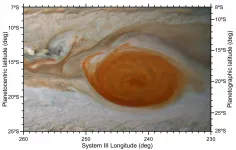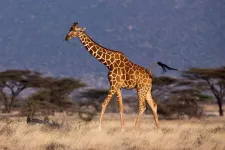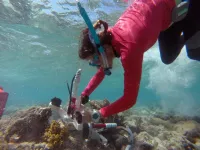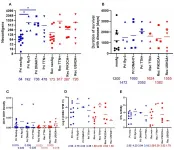(Press-News.org) WASHINGTON-- The stormy, centuries-old maelstrom of Jupiter's Great Red Spot was shaken but not destroyed by a series of anticyclones that crashed into it over the past few years.
The smaller storms cause chunks of red clouds to flake off, shrinking the larger storm in the process. But the new study found that these disruptions are "superficial." They are visible to us, but they are only skin deep on the Red Spot, not affecting its full depth.
The new study was published in the Journal of Geophysical Research: Planets, AGU's journal for research on the formation and evolution of the planets, moons and objects of our solar system and beyond.
"The intense vorticity of the [Great Red Spot], together with its larger size and depth compared to the interacting vortices, guarantees its long lifetime," said Agustín Sánchez-Lavega, a professor of applied physics at the Basque Country University in Bilbao, Spain, and lead author of the new paper. As the larger storm absorbs these smaller storms, it "gains energy at the expense of their rotation energy."
The Red Spot has been shrinking for at least the past 150 years, dropping from a length of about 40,000 kilometers (24,850 miles) in 1879 to about 15,000 kilometers (9,320 miles) today, and researchers still aren't sure about the causes of the decrease, or indeed how the spot was formed in the first place. The new findings show the small anticyclones may be helping to maintain the Great Red Spot.
Timothy Dowling, a professor of physics and astronomy at the University of Louisville who is a planetary atmospheric dynamics expert not involved in the new study, said that "it's an exciting time for the Red Spot."
Stormy collisions
Before 2019, the larger storm was only hit by a couple of anticyclones a year while more recently it was hit by as many as two dozen a year. "It's really getting buffeted. It was causing a lot of alarm," Dowling said.
Sánchez-Lavega and his colleagues were curious to see whether these relatively smaller storms had disturbed their big brother's spin.
The iconic feature of the gas giant sits near its equator, dwarfing earthly concepts of a big bad storm for at least 150 years since its first confirmed observation, though observations in 1665 may have been from the same storm. The Great Red Spot is about twice the diameter of Earth and blows at speeds of up to 540 kilometers (335 miles) per hour along its periphery.
"The [Great Red Spot] is the archetype among the vortices in planetary atmospheres," said Sánchez-Lavega, adding that the storm is one of his "favorite features in planetary atmospheres."
Cyclones like hurricanes or typhoons usually spin around a center with low atmospheric pressure, rotating counter-clockwise in the northern hemisphere and clockwise in the southern, whether on Jupiter or Earth. Anticyclones spin the opposite way as cyclones, around a center with high atmospheric pressure. The Great Red Spot is itself an anticyclone, though it is six to seven times as big as the smaller anticyclones that have been colliding with it. But even these smaller storms on Jupiter are about half the size of the Earth, and about 10 times the size of the largest terrestrial hurricanes.
Sánchez-Lavega and his colleagues looked at satellite images of the Great Red Spot for the past three years taken from the Hubble Space Telescope, the Juno spacecraft in orbit around Jupiter and other photos taken by a network of amateur astronomers with telescopes.
Devourer of storms
The team found the smaller anticyclones pass through the high-speed peripheral ring of the Great Red Spot before circling around the red oval. The smaller storms create some chaos in an already dynamic situation, temporarily changing the Red Spot's 90-day oscillation in longitude, and "tearing the red clouds from the main oval and forming streamers," Sánchez-Lavega said.
"This group has done an extremely careful, very thorough job," Dowling said, adding that the flaking of red material we see is akin to a crème brûlée effect, with a swirl apparent for a few kilometers on the surface that doesn't have much impact on the 200-kilometer (125-mile) depth of the Great Red Spot.
The researchers still don't know what has caused the Red Spot to shrink over the decades. But these anticyclones may be maintaining the giant storm for now.
"The ingestion of [anticyclones] is not necessarily destructive; it can increase the GRS rotation speed, and perhaps over a longer period, maintain it in a steady state," Sánchez-Lavega said.
INFORMATION:
AGU (http://www.agu.org) supports 130,000 enthusiasts to experts worldwide in Earth and space sciences. Through broad and inclusive partnerships, we advance discovery and solution science that accelerate knowledge and create solutions that are ethical, unbiased and respectful of communities and their values. Our programs include serving as a scholarly publisher, convening virtual and in-person events and providing career support. We live our values in everything we do, such as our net zero energy renovated building in Washington, D.C. and our Ethics and Equity Center, which fosters a diverse and inclusive geoscience community to ensure responsible conduct.
Notes for Journalists
This research study will be free available for 30 days. Download a PDF copy of the paper here. Neither the paper nor this press release is under embargo.
Paper title:
"Jupiter's Great Red Spot: strong interactions with incoming anticyclones in 2019"
Authors:
Agustín Sánchez-Lavega, corresponding author, (Universidad del País Vasco UPV/EHU)
Asier Anguiano-Arteaga (Universidad del Pais Vasco UPV/EHU)
Peio Iñurrigarro (Universidad del Pais Vasco UPV/EHU)
Enrique Garcia-Melendo (Universitat Politècnica de Catalunya UPC)
Jon Legarreta (Universidad del País Vasco)
Ricardo Hueso (UPV/EHU)
Jose Francisco Sanz-Requena (Universidad Europea Miguel de Cervantes)
Santiago Perez-Hoyos (Universidad del Pais Vasco UPV/EHU)
Iñigo Mendikoa (Universidad del Pais Vasco UPV/EHU)
Manel Soria (Universitat Politècnica de Catalunya UPC)
Jose Rojas (Universidad del Pais Vasco UPV/EHU)
Marc Andrés-Carcasona (Universitat Politècnica de Catalunya UPC)
Arnau Prat-Gasull (Universitat Politècnica de Catalunya UPC)
Iñaki Ordoñez-Etxebarria (Universidad del País Vasco UPV/EHU)
John Rogers (British Astronomical Association)
Clyde Foster (Astronomical Society of Southern Africa)
Shinji Mizumoto (Association of Lunar and Planetary Observers ALPO-Japan)
Andy Casely (Independent scholar)
Candice Hansen (Planetary Science Institute)
Glenn Orton (Jet Propulsion Laboratory, California Institute of Technology)
Thomas Momary (Jet Propulsion Laboratory)
Gerald Eichstädt (Independent scholar)
Toronto, ON -A new study published in the journal Substance Use and Misuse has found that adverse childhood experiences, such as physical and sexual abuse and neglect, predict greater performance-enhancing substance use in young adults.
Analyzing a sample of over 14,000 U.S. young adults from the National Longitudinal Study of Adolescent to Adult Health, researchers found that adverse childhood experiences are strongly associated with both legal (e.g., creatine monohydrate) and illegal (e.g., anabolic-androgenic steroids) performance-enhancing substance use. This relationship was especially strong among individuals who experienced ...
(March 17, 2021) -- Eric Shattuck, assistant professor of research in the UTSA Institute for Health Disparities Research (IHDR) at The University of Texas at San Antonio, is studying the phenomenon of social distancing in response to infectious disease and its effects on pathogen transmission and the health of individuals and communities.
Many animals, including humans, exhibit behavioral changes during the early stages of an infection, including reduced social contacts, called sickness behavior. His findings suggest innate social distancing might help prevent the infection ...
Gun violence in popular prime-time broadcast television dramas has increased steadily over almost two decades, a trend that parallels the rise in U.S. homicide deaths attributable to firearms, according to research by the Annenberg Public Policy Center (APPC) of the University of Pennsylvania.
Overall gun violence on popular prime-time dramas doubled from 2000 through 2018, according to the study, which was published in PLOS ONE. More important, gun violence as a proportion of the violence depicted in the shows rose significantly as well.
"Our research found that gun use substantially increased from 2000 to 2018 on prime-time ...
A study led by researchers at the University of California San Diego Jacobs School of Engineering provides new insights for developing therapies for muscle disease, injury and atrophy. By studying how different pluripotent stem cell lines build muscle, researchers have for the first time discovered how epigenetic mechanisms can be triggered to accelerate muscle cell growth at different stages of stem cell differentiation.
The findings were published Mar. 17 in Science Advances.
"Stem cell-based approaches that have the potential to aid muscle regeneration and growth would improve the quality of life for many people, from children ...
ROCHESTER, Minn. -- Pharmacogenomics is a valuable tool for health care providers to help prescribe the right drug for the right patient to enhance efficacy and avoid side effects.
A new research paper funded in part by the National Heart, Lung and Blood Institute (NHLBI) shows a clear advantage of genetic testing in helping health care providers choose the appropriate anti-platelet drug. Testing helps determine if a patient carries genetic variants in CYP2C19 that cause loss of its function. These variants interfere with the body's ability to metabolize and activate clopidogrel, an anti-platelet medication.
Anti-platelet drugs are given to prevent complications from blood clotting after a procedure to open clogged arteries. These patients can use one of ...
While scientists have known that creatures may adjust the timing of their daily routines based on starvation and predation, these shifts have only previously been measured based on data from a population at a single point in time. Now, using data collected as 71 elephant seals undertook their foraging migrations across the North Pacific Ocean, researchers report a view of how these animals divide their time between light and darkness to optimize tradeoffs between risks and rewards based on 7 months of data per seal, collected between 2004 and 2012. Their findings refute a hypothesis about how seals prioritize feeding. To better understand how seals divide their time between light ...
The giraffe is a truly puzzling animal. With its exceptional anatomy and suite of evolutionary adaptations, the giraffe is an outstanding case of animal evolution and physiology. Now, an international team of researchers from the University of Copenhagen and Northwestern Polytechnical University in China have produced a high-quality genome from the giraffe and investigated which genes are likely to be responsible for its unique biological features.
The extraordinary stature of the giraffe has led to a long list of physiological co-adaptations. The blood pressure of the giraffe, for instance, is twice as high as in humans and ...
Washington, DC-- Algae colonizing dead coral are upending scientists' ability to accurately assess the health of a coral reef community, according to new work from a team of marine science experts led by Carnegie's Manoela Romanó de Orte and Ken Caldeira. Their findings are published in Limnology and Oceanography.
Corals are marine invertebrates that build tiny exoskeletons, which accumulate to form giant coral reefs. Widely appreciated for their beauty, these reefs are havens for biodiversity and crucial for the economies of many coastal communities. But they are endangered by ocean warming, seawater ...
Information on individuals' mobility--where they go as measured by their smartphones--has been used widely in devising and evaluating ways to respond to COVID-19, including how to target public health resources. Yet little attention has been paid to how reliable these data are and what sorts of demographic bias they possess. A new study tested the reliability and bias of widely used mobility data, finding that older and non-White voters are less likely to be captured by these data. Allocating public health resources based on such information could cause disproportionate harms to high-risk elderly and minority groups.
The study, by researchers at Carnegie Mellon University (CMU) and Stanford University, appears in the Proceedings of the ...
Oncotarget published "Genomic and neoantigen evolution from primary tumor to first metastases in head and neck squamous cell carcinoma" which reported that prior work has characterized changes in the mutation burden between primary and recurrent tumors; however, little work has characterized the changes in neoantigen evolution.
These authors characterized genomic and neoantigen changes between 23 paired primary and recurrent head and neck squamous cell carcinoma (HNSCC) tumors.
Within these tumors, they identified 6 genes which have predicted neoantigens in 4 or more patients.
Within HNSCC tumors examined in this Oncotarget ...



